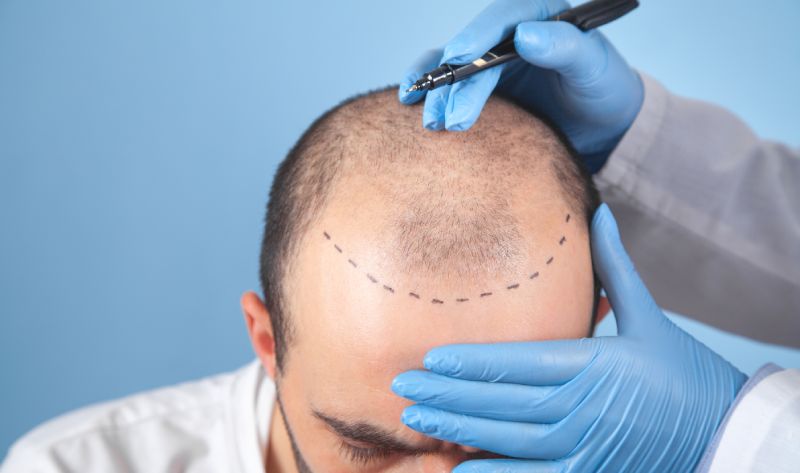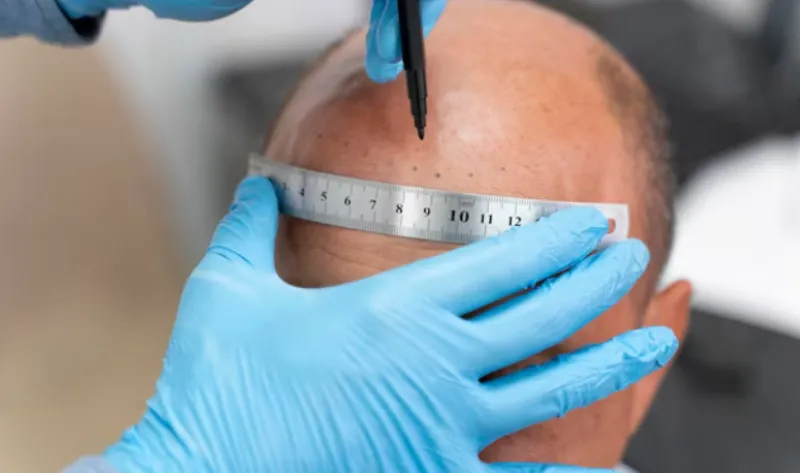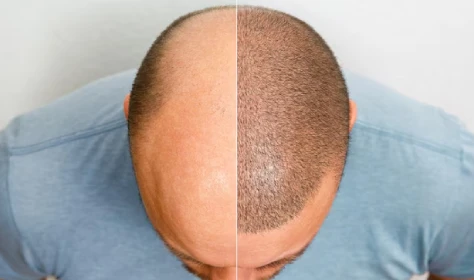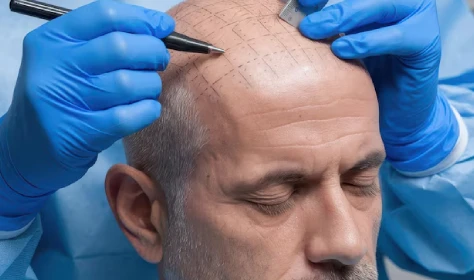When thinking about undergoing any surgery like a hair transplant, people often start worrying about the treatment’s side effects before paying attention to the benefits. Many questions strike their mind like What will happen to the donor area after the hair transplant? Will it become thinner? Will there be scarring? Does hair grow after a hair transplant? Is hair transplant safe? Will the donor site appear all covered and natural? What is a hair transplant hair growth timeline? If any of such questions are bothering you, you have come to the right page to get answers. Scroll down to see how hair transplant affects the donor site.
But before that, understand the basics of hair transplant procedure with the insights shared by Dr. Urvashi Chandra, a prominent and experienced hair transplant surgeon in Delhi.
A hair transplant is a surgical, cosmetic procedure to treat alopecia or hair loss and restore a head full of thick, healthy hair. It involves harvesting hair grafts from the back or sides of the scalp-called donor areas to the sites of hair loss or hair thinning- the recipient areas.
Before attempting a hair transplant, the most important factor that has to be analysed is the donor area. Many people think that hair grows after a hair transplant. For covering a large area of baldness or hair loss, the donor area must have sufficient healthy, thicker hair to provide the required number of grafts. This means thinning of the donor site is not right as it can lead to unsuccessful hair transplant.
So, does donor area hair grow back after a hair transplant? The answer to this is both yes or no.
There are a couple of factors that have a role in determining the growing back of donor hair. The factors also determine how long it will take for normal hair growth to return from the donor area. These include:
In further sections, these two factors are explained in detail.
There are different techniques available for hair transplantation: Traditional Follicular Unit Transplantation/Strip Method and Advanced Follicular Unit Extraction.
In a Follicular Unit Transplantation, a linear cut is made in the donor area to take out a thin strip of hair. As a thin hair strip with skin is removed and stitches are used to close the incision, it’s difficult to notice a reduction in the density of the donor's hair. After the FUT hair transplant, the hair of the donor area grows naturally.
For a Follicular Unit Extraction, the surgeon makes micro punches in the donor area to directly and fully extract the hair follicles. New hair will come out in the donor site only if there are healthy hair follicles present. As FUE hair transplantation involves the extraction of hair follicles, the regrowth of the donor's hair is not possible in the sites where there is an absence of hair follicles or hair roots. Hence, it is very important to analyse the donor area before hair transplantation to avoid emptying any donor zone. The surgeon must leave behind enough healthy hair follicles at the site of graft extraction to keep specific donor areas all covered up without looking thin or scarred.
As there is some reduction in the density of hair in the donor area following a hair transplant, an expert hair transplant surgeon will never extract more donor hair than what is safe to extract. In case the scalp donor hair is insufficient then the beard or the chest area can fill up the scalp region that is bald in men.
Read more : Advanced Hair Examination by An Expert Hair Transplant Surgeon
A good surgeon will always first calculate how much donor area can be spared for the transplant. How the calculations are made, can be better understood with the following examples:
A donor area of a typical person with grade 4 hair loss, affecting the vertex or the crown area has somewhere close to 20,000 grafts available. As hair loss from the vertex can grow in the coming years, the top zone of the donor area which means the top 1/3rd area of the donor part is considered unsafe for graft extraction. So, what’s left is the bottom 2/3rd part of the donor area which comprises around 14,000 grafts.
Out of these 14,000 grafts, the surgeon must spare at least 50% of the grafts for extraction. This means 7,000 grafts are only available in such cases to make sure that the donor area remains covered and not thins out after a hair transplant. In other terms, throughout the multiple sessions of hair transplant, the maximum that a surgeon can extract from the scalp donor area is 7,000 grafts.
This is the case of the donor area of a grade 4 Androgenetic Alopecia person with vertex thinning who is around the age of 30 years. If the same amount of thinning happens in a younger person, then the surgeon has to leave behind more of the upper part of the donor zone as it might be unsafe.
For a person with severe baldness (stage 5 or 6), there is larger hair loss at the vertex or the crown area. This means a narrower donor area and the availability of less amount of donor grafts for extraction. Age is a big factor, so a young person with a higher grade of baldness is a poor candidate for a hair transplant because there is no knowledge of whether any part of the donor area is safe for extraction or not for a lifetime. For more details on graft requirements and hair transplants in Delhi, one can get in touch with Chandra Clinic experts.
Immediately after hair transplant surgery, the surgeon places a sterile bandage on the donor area. The bandage is removed the next day, after 24 hours of the end of the surgery. After this, the donor area starts to gradually heal. The discomfort usually is gone in a couple of days. In the initial 3 to 4 days of recovery, the donor area usually heals completely which means that the literal dots that were formed because of extracting grafts are filled up with new skin. However, the tiny marks and the redness take some more days to resolve. After full recovery from a typical FUE hair transplantation, the little white dots remain in the donor site. In the case of a FUT hair transplantation, a linear scar is formed over the donor site where the hair strip was removed.
At 11-50 days following the surgery, the donor area looks as if the patient has trimmed his/her scalp. That’s because the little hair that was not extracted from the donor site during the hair transplant, but was only shaved, started growing. If a BIO IPT hair transplant is performed, usually after two weeks, no one except the surgeon and patient can make out that grafts have been extracted from the donor area.
If you think about how the donor site would look like after hair transplantation, you can check hair transplant before and after at Chandra Clinic and can better understand with the following example:
If the surgeon has extracted roughly 3,000 to 3,500 grafts in a donor area that has a lifetime capacity of 7,000 grafts, then after 8 to 10 months of single sitting, there’s absolutely no visible difference in the look of the donor area. For this, it is important to keep the hair at least about one centimetre long so that the donor area can look the same as it was looking previously.
However, after the second sitting the remaining 3,500 grafts are also extracted which means once the total lifetime donor bank is extracted from the donor area, the donor area might look slightly thinner as compared to the original point. However, if the hair is kept slightly long no difference can be made out. Therefore, the surgeon needs to assess the donor capacity before doing the graft extraction if the donor has thin or fine hair then the total donor capacity will be less because there will be a requirement for more fine hair as compared to thick hair to keep the donor area fully covered and make sure that the skin of the donor area is not visible.
After a hair transplant surgery, patients are recommended to strictly follow all surgeon’s recommended care instructions to ensure a smooth and healthy recovery. If you have undergone a hair transplant surgery, you will be advised to:
By carefully following aftercare instructions specific to the donor area, the patient can ensure good hair growth in the donor site after the hair transplant.
Hair transplant results are always a mixture of proper use of art and science. The science behind hair transplant equates to getting the surgery done by a qualified doctor and not by technicians. At our Clinic, we use cutting-edge technologies and ensure the use of safe, emergency, and hygiene protocols. We even appoint a team of surgeons with a wealth of experience in doing hair transplants while delivering unparalleled results.
The artistic aspect of a hair transplant is equally important and this equates to choosing a hair transplant surgeon with great artistic vision. It can ensure maximum coverage and best look with the same number of grafts. If the grafts are not implanted artistically by taking care of the right angle direction and depth then despite putting in a good number of grafts, the hair transplant result might look less dense and unnatural. You can also get hair transplant surgery cost in Delhi at competitive prices at Chandra Clinic.
At our clinic, we understand the natural hair growth pattern of our patients and try to recreate the same natural look in the closest manner possible in areas of hair loss.



